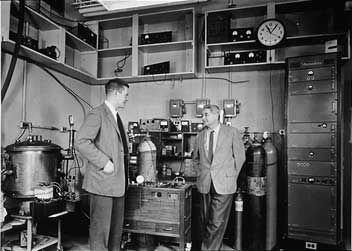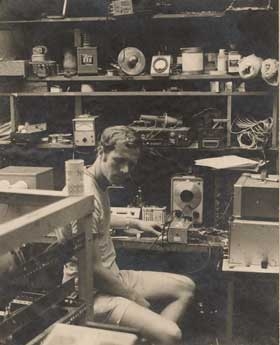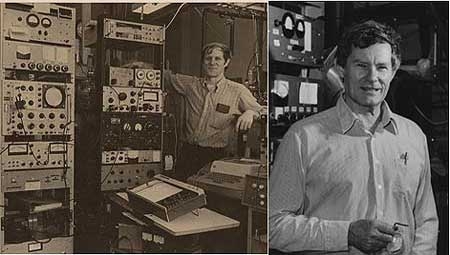Having a mentor can be an essential boost to your initial education. If you are lucky enough to have a mentor throughout your career, the benefit multiplies. The scientific world lost an extraordinary mentor to thousands of students last June when John G. King, professor emeritus of physics at MIT, passed away. I joined a number of John’s past students and colleagues for a memorial celebration that was held at MIT on October 24. I offered the following personal remarks during this gathering to characterize what I learned from John’s teaching, wizardry in the laboratory, and remarkable, unbounded curiosity about the world around us:

I am a fortunate student of John. I use the present tense even though I stopped officially being a student at MIT in 1975—one never stops being a student of and learning from John. My second good fortune was to have had the opportunity to overlap three of John’s periodic transitions in scientific focus during my nine-year student career at MIT. I started as John was wrapping up experiments with the study of molecular beams, which included his prior work with Jerrold Zacharias in building a practical version of the atomic clock; the invention is still used around the world as a time standard. As I spent my undergraduate and graduate years under his tutelage, I experienced the start-up and peaking of his research with superfluid helium and the start-up of his multifaceted approach to microscopy and biological surfaces.
You can get a peek at John’s academic diversity by reviewing the titles of the 20 PhD theses and more than 30 BS/MS theses he supervised during his career.
This leads me to John’s first rule of scientific life:
“I don’t care how smart you are, if you study something for five years, you can be considered an expert.”
That led to John’s propensity for significantly changing his field of study during his active research career: from classical molecular beams and atomic physics, to low-temperature physics, to electron and novel forms of microscopy, to biophysics. The timescales for these transitions was about five years. This kind of rubbed off on me, but my DNA could not deal with that short of time period for a complete makeover. I changed my field every seven to eight years—from atomic physics, low-temperature and biophysics during my nine-year career with John, to high-temperature then low-temperature plasma physics, to accelerators, to lasers, and to my present job, which has moved from the “retail” to “wholesale” level of promoting physics as the current executive director of AIP.
Throughout my entire time with John at MIT, he had a constant interest in improving science education; my first experience with him was as a Physics Project Lab student during my first undergraduate year at MIT. This unique, self-directed laboratory was experienced by more than 2,000 students and is the subject of a book that will be published this month by Oxford University Press. From my Project Lab experience, I was exposed to another of John’s lessons for scientists:
“There is something interesting in explaining how the most ordinary and mundane things work.”
I remember him telling us how much physics was hidden in trying to understand the lifetime and reliability of relay contacts. Since this was not a fully solved problem, we are thankful that Bell Labs hired “quantum mechanics” in the 1930s and moved on to solid state switches.
My Project Lab experiment in the fall of 1967 was looking at the possibility of helium atom diffraction. Not yet being sophisticated enough to run and operate a low-temperature atomic beam, my lab partner, Mark Ketchen, who went on to head the Physics of Information Group at IBM Yorktown, and I did a scaled diffraction experiment with light.
Several weeks into the Project Lab experience, I realized I could learn a lot from John King, and from that semester on—several years before the Undergraduate Research Opportunities Program (UROP) was formalized at MIT—my second home was John’s lab.

We talked and heard about his first experiments with “Concentrated Study” as a classroom activity that condensed a full semester course into three weeks. (We had concentrated study with every activity in John’s lab.) From that first experience with Project Lab throughout the remainder of my undergraduate career, including summers, I worked in the Molecular Beam Lab—first as a general handyman cleaning diffusion pumps for the graduate students, and then learning how to make electron multipliers from scratch. But I soon moved on to my own undergraduate research; this culminated in the second version of John’s classic neutrality experiment, which held the record for how exactly the charge on the electron and proton are equal in magnitude for 50 years.
This acoustic version was published in Physical Review in 1971[1] and held the world record for this limit, until it was eclipsed by an Italian group who redid the experiment in 2012 by spending 200,000 times more money than we did, having borrowed equipment and supplies from the then-rich stores of surplus gear in MIT’s Research Lab of Electronics. My total expenditure was less than $4.00, for two crystal microphones procured at the local RadioShack.
For my graduate work I was in the thick of the first suite of graduate students devoted to molecular microscopy and watched John attract collaborators from medical schools and electron microscopy aficionados to enrich the collaboration. My graduate work resulted in a working prototype of his idea for a molecular microscope that imaged water molecules evaporating or stimulated from surfaces.

By the time I left MIT for a post-doc at Princeton in 1975, my graduate experience had taught me how to design, build, operate, and model the data from crude to more sophisticated working instruments built from scratch. My microscope went through at least three improved versions before I was granted my PhD. Five years after leaving MIT, I was able to really complete the aspiration of my original PhD thesis project: imaging individual biological cells. At Princeton I joined a fellow MIT student, Sam Cohen, and we amassed a suite of state-of-the-art surface analysis equipment for Princeton’s magnetic fusion program. With this more sophisticated equipment and a persistence drilled into all King students, John and I garnered an article in Nature,[2] which showed images of my own red blood cells.
My most vivid memories of John remain from the frequent group lunches in MIT’s Walker Memorial cafeteria, attended by most of the graduate students and several undergraduates, where John would hold court. The topics would range from discussions of our late-night adventures in the lab; to John’s stories of his adventures as a kid in New England who could outsmart the local power providers when he needed a little more juice for his basement experiments; to why even the basic physics of the lifetime of a conventional electromagnetic relay is rich in science. Our conversations about science and engineering were far ranging, but on the rare occasion that some obscure effect didn’t interest John, we heard this famous line which his students had engraved on a plaque for his office:
“You can’t expect me to explain every cruddy little phenomenon.”
I have never met another person like John, and my entire scientific career was enriched and made possible by John’s friendship and mentorship.
I end this tribute with John’s last rule for life in science:
“Don’t be so impressed with the big weenies—wherever they show up—in science, academia, or government.”
John was the opposite of the trumped-up personality, who is often too self-confident and ego drenched for their own good. He was genuine, dedicated to trying to help you understand the world around you—especially with respect to physics—but also with life in general. He cared about you as a person, your family, the books you read or should be reading, the food or wine that you should sample, and he didn’t ignore anything that life could teach you. I owe almost everything in my training and behavior as a scientist to sharing many of my formative years with John King.
I was very fortunate to have such a mentor. Even though I have always learned from colleagues in my environment, John King’s influence on me will be unreplaceable.
_________________________________
To learn more, you can tap into history from the source. Read the oral history interview of John King conducted by George Zimmerman in 2009 through AIP’s Niels Bohr Library and Archives.
